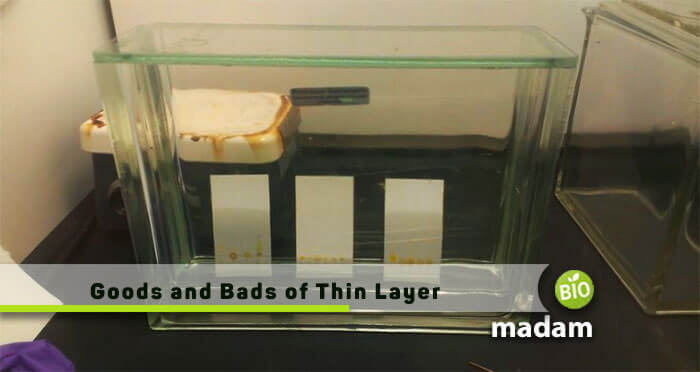Thin-layer chromatography (TLC) is a chromatographic separation technique used to separate non-volatile compounds from a mixture. It utilizes a thin layer of a material on which an adsorbent is coated (stationary phase) to attach the compound being separated or analyzed in the liquid mixture (mobile phase).
While there are many advantages associated with this technique, it also offers some disadvantages or limitations that must be kept in mind when one plans to include it in one’s workflow. Let’s take a look at them individually.
Advantages of Thin Layer Chromatography
The best advantage which TLC offers is saving time as compared to traditional paper chromatography. For instance, while chromatographic separations using paper chromatography can take up to a daylong procedure to develop the bands or spots, TLC is quite robust. It takes only about half an hour or so for chromatographic separations.
It requires minimal equipment for carrying out the TLC procedure. For example, it needs only a TLC plate, TLC chamber, fume cupboard, and chamber as major components to run a sample to be separated into its components.
As it is a fast technique, an additional advantage being bargained by it is the large number of samples that can be run in a single time along with a plate.
It is a susceptible technique providing confidence in the accuracy of the results. For example, TLC helps in the analyses of the compounds present in amounts of the order of micrograms, thus rivaling other separation methods.
It is also useful if a small sample volume is available and does not require huge samples. For example, if someone has a sample of a volume of only a few microliters, it can be used to run in thin-layer chromatographic separations.
It allows for the identification of the compounds. This is mainly carried out by comparing the compound separated on the TLC plate with some standard (pure form of the compound being identified) run alongside the experimental separation and afterward comparing the sample with the standard.

Besides providing colorimetric detection of separations, compounds responsive to UV light can also be separated via thin-layer chromatography. For example, various biological and chemical compounds give fluorescence under UV, and with TLC, it is possible to visualize such separations under UV. Moreover, individual components can be identified as the background does not give fluorescence.
It is also advantageous when it is required to quantify the separations. Most often, this is done by running different TLCs and then plotting a standard curve of them. Then the separations can be quantified by comparing them with the standard curves.
It also allows for the recovery of the components that got separated through TLC. This is easily done by scraping the spot containing the desired component, and the adsorbent layer along with that component gets detached off from the TLC plate. This can then be collected and used for further analyses.
It gives a complete picture of the number of components present in a mixture. For example, if a sample contained 10 components, the appearance of 10 spots on the TLC plate would clearly indicate their number.
Various instruments for TLC are available commercially, which provide automation for the process. This has not been possible for paper chromatography. The automation facilities available in such instruments can be summarized as an autosampler, the sample dispensing at constant volumes, a documentation system, and cameras for capturing and recording pictures of the separations.
It also holds a rigid support system in its very basic design. For example, the adsorbents in TLC are coated into rigid plates instead of papers in paper chromatography. This links with additional advantages such as reproducibility, compound detection, faster separation of spots, quick identification of number of compounds, less diffusivity, and development of well-defined spots.
It also presents a greater choice of adsorbents to be covered on the plates. These range from liquid and solid coated adsorbents to fluorescent adsorbents as well.
Corrosive spray reagents – needed in some compounds’ analyses – can be used on TLC. This is because TLC plates display greater withstanding abilities for these reagents than some primitive chromatographic techniques.
Another advantage is that the thin layer of chromatographic plates can withstand the heating required in some cases to develop spots. This gives an edge to TLC over other chromatographic techniques unable to bear high temperatures.
It allows for some large-scale isolations of compounds often needed in preparative quantities for downstream experimentations. This becomes possible by using TLC plates covered with thick coatings of the adsorbents to retain higher amounts of compounds to be separated.
It is a cost-effective technique that allows for the separation of multiple samples and better detection without getting diffused into each other. So this is an economic benefit for the labs or institutions having lesser amounts of funds.
Disadvantages of Thin Layer Chromatography
One of its limitations is that TLC cannot distinguish between a compound’s isomeric and enantiomeric forms despite its convenience and simplicity. This is because the chiral pairs of a molecule exhibit the same physical properties.
And since thin layer chromatography is a physical separation technique, thus it is unable to define a distinction between chiral molecules. Moreover, the solid components or solvents used in TLC are not chiral; therefore, enantiomers can not be differentiated.
The requirement of pre-known Rf values presents another challenging disadvantage associated with thin-layer chromatography. For example, identifying specific compounds after separation from a mixture requires that their Rf values be known beforehand to be compared with them and determined.
Some of the TLC plates do not have long stationary phases. In such cases, it poses the limitation of the length of separation for the mixture. The greater the length of the plate, the finer would be the separation of the mixture into individual components.
Since TLC operates within the confines of an open system, it is susceptible to being affected by environmental factors such as temperature and humidity, etc. These factors can have consequent effects on the results of the separation on the chromatogram.
More than one compound or different separations can be done in a single run only as long the mobile phase is the same for all the separations being carried out. Otherwise, different runs on separate plates would be necessary in case of separations demanding separate mobile phases.
While the plates for thin-layer chromatography are being prepared, the adsorbent is coated on the plates using different methods. Another disadvantage associated with this procedure is that the thickness or coating of the adsorbent on the plate surface is not uniform, which can sometimes lead to differences in the results of experiments. Also, a large quantity of coating slurry is required even for preparing a few TLC plates.
If extra-large spots of a compound are formed in a separation experiment, they may overlap with the Rf values of the spots of other compounds. This can lead to ambiguity in the results and misleading interpretations.
TLC applies to only nonvolatile compounds, thus limiting its use.
The resolution capacity of thin layer chromatography ranges from 10-50 separations. This poses a major limitation for mixtures in which the number of compounds goes beyond this range, making TLC inapplicable for such separations.
Although automation has been done for some of the individual steps of TLC, it lacks the presence of a fully automated system.

Jeannie has achieved her Master’s degree in science and technology and is further pursuing a Ph.D. She desires to provide you the validated knowledge about science, technology, and the environment through writing articles.

